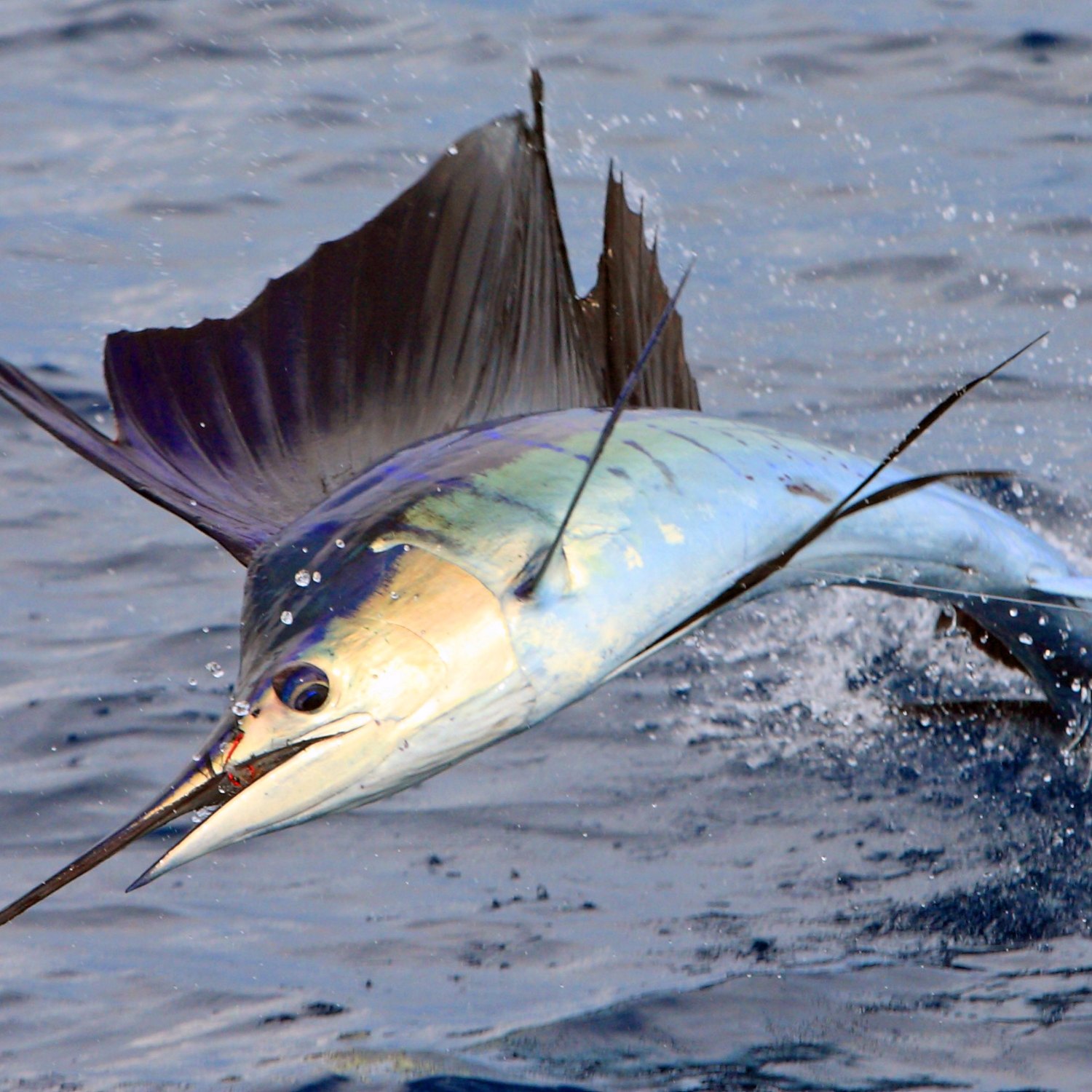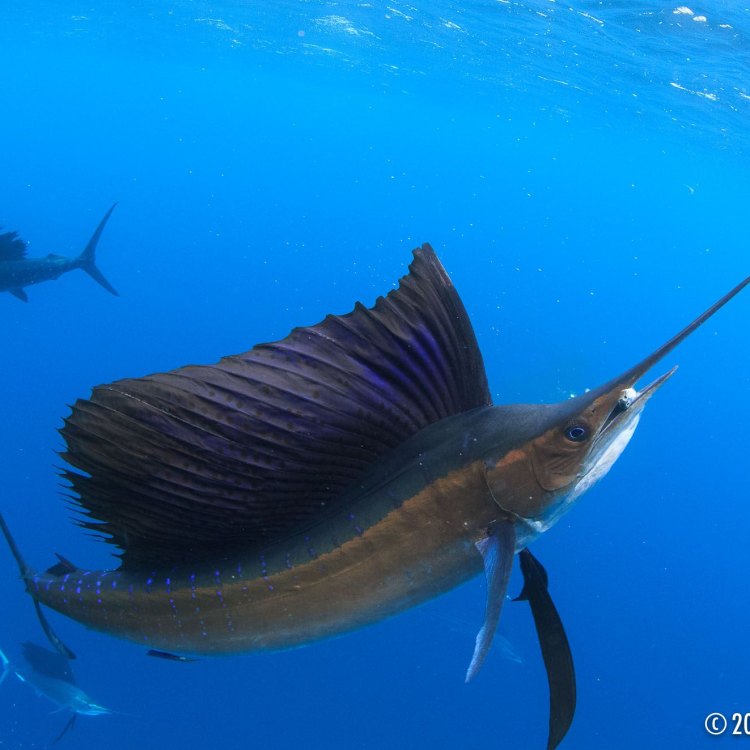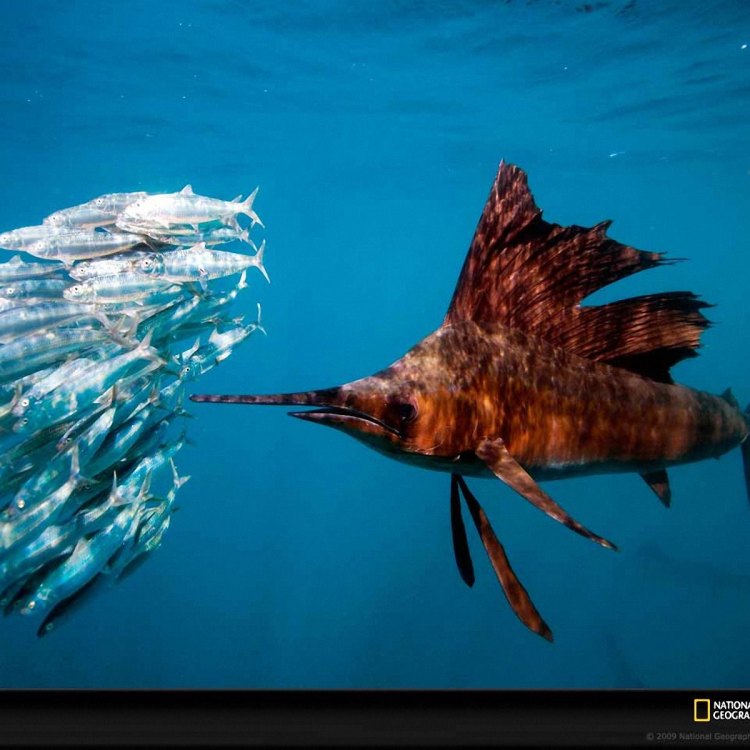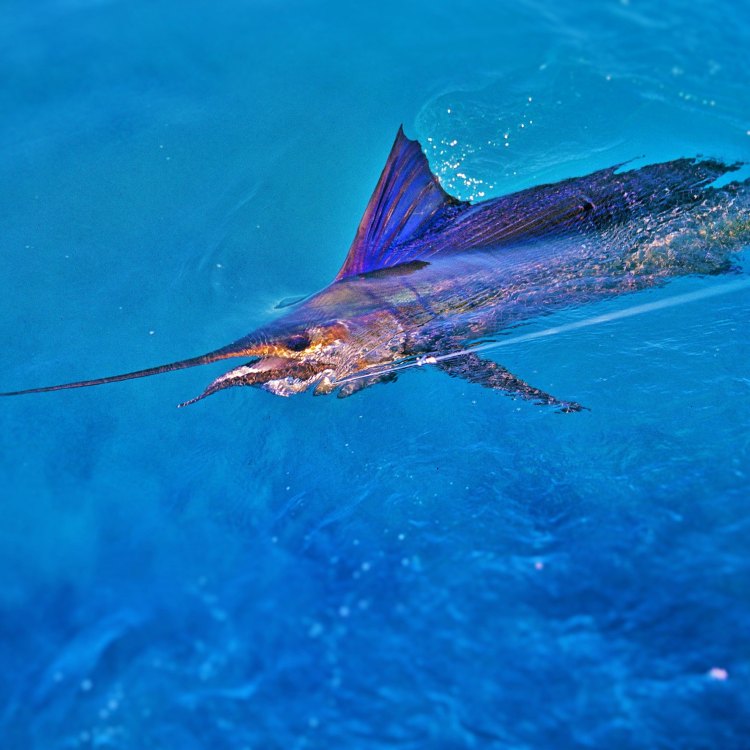
Sailfish
Up to 11 feet (3.35 meters)
Sailfish are incredibly fast and streamlined animals, with lengths of up to 11 feet! Found in coastal waters around the world, they are part of the Istiophoridae family and are known for their ability to swim at high speeds. With their sleek body shape, these creatures are truly a marvel of nature. Keep an eye out for these majestic creatures on your next trip to the coast!
Animal Details Summary:
Common Name: Sailfish
Kingdom: Animalia
Habitat: Open waters of the tropical and subtropical oceans
The Mighty Sailfish: The Fastest Fish in the Ocean
Have you ever heard of the sailfish? If you haven't, you're in for a treat. The sailfish is a marine animal that belongs to the family Istiophoridae, and can be found in the open waters of the tropical and subtropical regions of the Atlantic and Indian Oceans. This magnificent creature is known for its impressive speed, sleek appearance, and stunning coloration. In this article, we will dive deep and explore the fascinating world of the sailfish Sailfish.But first, let's get to know this incredible animal.
Scientifically known as Istiophorus platypterus, the sailfish is a large species of marine fish that belongs to the kingdom Animalia, phylum Chordata, class Actinopterygii, and order Perciformes. It is closely related to other popular fish species such as marlins and swordfishes. Its unique name comes from its long, sail-like dorsal fin, which can be easily spotted in the waters.
Habitat and Distribution
The sailfish is a highly migratory species and can be found in the warm waters of the Atlantic and Indian Oceans. It prefers to inhabit the open waters of the tropical and subtropical regions, making it a popular game fish for recreational anglers. However, they can also be found in the coastal waters of various countries, including Mexico, Costa Rica, India, and many more.The vast range of their geographical distribution is due to their migratory behavior, which is influenced by factors such as water temperature and food availability. During colder months, they tend to move towards the equator, while in warmer months, they migrate towards the poles Sand Cat.
Appearance
One of the key features that make the sailfish stand out is its strikingly beautiful coloration. The upper body is a beautiful blue-gray color, while the sides and belly are a shimmering silver. This coloration not only adds to their beauty but also serves as a form of camouflage, helping them blend in with their surroundings and sneak up on their prey.Another notable physical feature of the sailfish is its long, sail-like dorsal fin, which can be as tall as its body length and is often brightly colored with shades of blue and purple. The dorsal fin is also used as a display, with males using it to attract females during the mating season.
Body and Size
The sailfish has a sleek and streamlined body, built for speed and agility. Its long, pointed snout and powerful, muscular body enable it to cut through the water at an incredible speed, making it the fastest fish in the ocean.On average, sailfish can grow up to 11 feet (3.35 meters) in length and weigh around 220 pounds (100 kilograms). However, there have been recorded instances of sailfish growing up to 14 feet (4 meters) in length and weighing over 220 pounds. This size and weight combination makes them a formidable predator in the ocean.
Feeding Habits
Sailfish are carnivorous animals, which means they eat meat. They primarily feed on smaller fish, such as sardines, mackerel, and tuna. They are skilled hunters and use their speed and agility to their advantage when catching their prey. They can often be seen hunting in groups, using their long bill to stun their prey before consuming them.To catch their prey, sailfish are known for their lightning-fast speeds, reaching up to 68 miles per hour (110 kilometers per hour). This makes them one of the fastest animals in the entire animal kingdom, not just in the ocean. Their long bill acts as a weapon, giving them an advantage in catching their prey, and is also used for defense against predators.
Life Cycle and Reproduction
The life cycle of the sailfish begins when they hatch from eggs laid by the female sailfish. Females can lay up to 4 million eggs at once, and once the eggs hatch, the larvae are left to fend for themselves. As the sailfish grows, its dorsal fin will gradually develop into the trademark sail.Once they reach maturity, around 4 years of age, they begin to reproduce. The courtship ritual involves the male sailfish showcasing their dorsal fin to the female, and once she selects a mate, they will spawn together. After spawning, the female will lay her eggs, and the cycle continues.
Sailfish can live up to 13 years in the wild, but their lifespan can be shortened by factors such as overfishing and habitat destruction.
The Sailfish and Humans
As mentioned earlier, the sailfish is a popular game fish among anglers. Their incredible speed and fighting spirit make them a prized catch for many recreational fishermen. However, their large size and strength also make them a challenging catch, requiring skill and experience to reel in.Unfortunately, due to their popularity in sports fishing, sailfish populations have been declining in recent years. To combat this, international fishing organizations have set up regulations and guidelines to ensure sustainable catches and the protection of these magnificent creatures.
Aside from sports fishing, the sailfish also plays an essential role in the marine ecosystem as a top predator. They help control the populations of smaller fish, which, in turn, maintains the balance of the underwater food web.
In Conclusion
The sailfish is indeed a magnificent creature of the sea, with its incredible speed, beauty, and hunting abilities. With a range of distribution spanning across the tropical and subtropical regions of the Atlantic and Indian Oceans, it is undoubtedly one of the most notable species in the marine world.However, with threats such as overfishing and habitat destruction, it is crucial that we take necessary measures to protect these creatures and ensure their population's sustainability. By doing so, we can continue to marvel at the wonders of the sailfish and appreciate its role in maintaining the balance of our oceans.
Next time you're near the open waters, keep an eye out for the sailfish, and you may just catch a glimpse of their impressive speed and agility in action.

Sailfish
Animal Details Sailfish - Scientific Name: Istiophorus platypterus
- Category: Animals S
- Scientific Name: Istiophorus platypterus
- Common Name: Sailfish
- Kingdom: Animalia
- Phylum: Chordata
- Class: Actinopterygii
- Order: Perciformes
- Family: Istiophoridae
- Habitat: Open waters of the tropical and subtropical oceans
- Feeding Method: Carnivorous
- Geographical Distribution: Atlantic and Indian Oceans
- Country of Origin: Numerous countries in the Atlantic and Indian Ocean regions
- Location: Coastal waters
- Animal Coloration: Blue-gray on the upper body, silver on the sides and belly
- Body Shape: Sleek and streamlined
- Length: Up to 11 feet (3.35 meters)

Sailfish
- Adult Size: Up to 11 feet (3.35 meters)
- Average Lifespan: 4-10 years
- Reproduction: Sexual
- Reproductive Behavior: Spawning
- Sound or Call: No specific sound or call
- Migration Pattern: Highly migratory, known to travel long distances
- Social Groups: Can be solitary or form small groups
- Behavior: Aggressive when hunting, known for their speed and acrobatic leaps
- Threats: Overfishing, habitat degradation, bycatch
- Conservation Status: Least Concern
- Impact on Ecosystem: Important predator in marine ecosystems
- Human Use: Game fish
- Distinctive Features: Long, slender body with a large dorsal fin resembling a sail
- Interesting Facts: Fastest fish in the ocean, capable of speeds up to 68 mph (110 km/h)
- Predator: Orcas, sharks

Istiophorus platypterus
Sailfish: The Mysterious and Majestic Ocean Predator
In the vast and mysterious world of the ocean lies an elusive and magnificent creature - the sailfish. With its long, slender body and large dorsal fin resembling a sail, this fish is a sight to behold. But beyond its distinctive appearance, the sailfish possesses some unique and fascinating features that make it a truly remarkable species. In this article, we will dive into the world of the sailfish and unravel some of its secrets PeaceOfAnimals.Com.Size, Lifespan, and Reproduction
The sailfish is one of the largest fish species in the world, with adult sizes reaching up to 11 feet (3.35 meters) in length. This impressive size, combined with their speed and agility, makes them formidable predators in the ocean.
On average, sailfish have a lifespan of 4-10 years. However, their life expectancy can be influenced by factors such as overfishing and habitat degradation, which we will discuss later on in the article.
Like many other fish species, sailfish reproduce sexually. Mating usually occurs through a process called spawning, where several males fertilize a female's eggs. This behavior ensures genetic diversity in the offspring, increasing their chances of survival in the wild.
Social Behavior and Migration Patterns
Sailfish are highly migratory creatures, known to travel long distances during certain times of the year Spanador. This behavior is believed to be influenced by changes in water temperature and food availability. Some sailfish populations are known to migrate up to 6500 miles (10,000 kilometers) in one year, making them true ocean nomads.
In terms of social behavior, sailfish can be solitary creatures or form small groups with other sailfish, especially during mating and feeding. These groups are usually composed of individuals of the same size, making it easier for them to coordinate hunting strategies.
Behavior and Hunting Habits
Sailfish are known for their speed and agility, making them one of the fastest fish species in the ocean. With their streamlined bodies and powerful muscles, they can reach speeds of up to 68 mph (110 km/h). But their impressive speed is not their only weapon when it comes to hunting. Sailfish are also known for their acrobatic leaps, often soaring out of the water to catch their prey.
When hunting, sailfish can become very aggressive, using their sharp bills to stun their prey. They are opportunistic feeders and will go after a variety of small fish, squid, and crustaceans. Their swift movements and powerful attacks make it challenging for their prey to escape their grasp.
Threats and Conservation Status
Despite being one of the most impressive predators in the ocean, sailfish face many threats that put their survival at risk. Overfishing, habitat degradation, and bycatch are three main factors that impact sailfish populations worldwide.
Overfishing is a significant threat to the sustainability of sailfish populations. They are a prized game fish and are highly sought after for sport fishing. Additionally, their meat is considered a delicacy in many countries, which has led to a significant decline in their numbers.
Habitat degradation, such as ocean pollution and oil spills, also poses a significant threat to sailfish. These creatures rely on a healthy and clean ocean ecosystem to thrive, and any disruption in their habitat can have severe consequences.
Bycatch, which refers to unintended catching of non-target species, is also a major threat to sailfish. As they are often caught in commercial fishing nets, they can become entangled and suffocated, leading to their death or serious injuries.
The International Union for Conservation of Nature (IUCN) lists the sailfish as Least Concern, with stable populations in many regions. However, the threats they face require continued monitoring and conservation efforts to ensure their survival in the future.
Impact on Ecosystem and Human Use
As top predators in marine ecosystems, sailfish play a crucial role in maintaining a healthy balance in the food chain. They control the populations of their prey species, preventing them from overpopulating and negatively impacting other species. This makes them an essential part of the ocean ecosystem.
From a human perspective, the sailfish is primarily used as a game fish. Its speed and agility make it a popular catch for sport fishermen. However, due to conservation efforts and the fact that they are not considered a sustainable source for commercial fishing, their catch is strictly regulated in most regions.
Interesting Facts and Predators
The sailfish's unique features and impressive abilities have captured the curiosity and fascination of many people worldwide. Here are some interesting facts about this mysterious and majestic creature:
- Sailfish are the fastest fish in the ocean, capable of reaching speeds of up to 68 mph (110 km/h).
- Their long dorsal fin, which gives them their iconic sail-like appearance, is used to confuse and corral their prey.
- Sailfish do not make any specific sound or call, but they are known to communicate with each other through subtle body movements.
- Their skin is covered in special cells called chromatophores, which help them change colors and patterns in a matter of seconds. This ability is used for communication and camouflage.
- Sailfish are closely related to marlins, and their dorsal fins can help differentiate them. Sailfish have a tall, narrow dorsal fin, while marlins have a shorter, more rounded one.
While sailfish may be one of the top predators in the ocean, they are not exempt from their own predators. Orcas (also known as killer whales) and sharks are their main predators, particularly when they are young and vulnerable.
In conclusion, the sailfish is a truly remarkable species, with its unique appearance, impressive abilities, and importance in the ocean ecosystem. While they may face threats to their survival, their resilience and adaptability give us hope that they will continue to thrive in the oceans and dazzle us with their majestic presence. Let's do our part in protecting this mystical and mysterious creature for future generations to come.

The Mighty Sailfish: The Fastest Fish in the Ocean
Disclaimer: The content provided is for informational purposes only. We cannot guarantee the accuracy of the information on this page 100%. All information provided here may change without prior notice.












